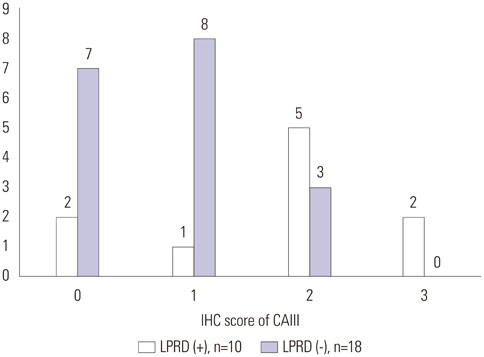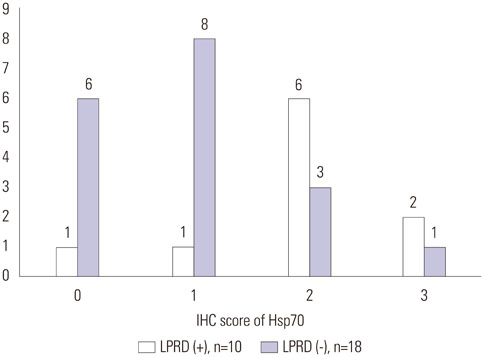Yonsei Med J.
2016 Mar;57(2):469-474. 10.3349/ymj.2016.57.2.469.
Expression of CAIII and Hsp70 Is Increased the Mucous Membrane of the Posterior Commissure in Laryngopharyngeal Reflux Disease
- Affiliations
-
- 1Department of Otorhinolaryngology-Head and Neck Surgery, Chung-Ang University College of Medicine, Seoul, Korea. seylee@hanmail.net
- KMID: 2374055
- DOI: http://doi.org/10.3349/ymj.2016.57.2.469
Abstract
- PURPOSE
We tried to evaluate the difference in the expression of carbonic anhydrase (CA) III and heat shock protein (Hsp) 70 between laryngopharyngeal reflux disease (LPRD) and non-LPRD patients.
MATERIALS AND METHODS
The study involved 28 patients who underwent laryngeal microsurgery due to benign laryngeal disease from March to August 2008. Reflux symptom index (RSI) and reflux finding score (RFS) were measured for each person, and they were assigned either to the LPRD group (n=10) or non-LPRD group (n=18). Tissue samples were obtained from the mucosa of posterior commissure, and immunohistochemistry (IHC) staining of CAIII and Hsp70 was performed. The IHC scores were measured and compared with clinical features including RSI and RFS.
RESULTS
Total 10 patients were assigned as LPRD group, and 18 patients were as control group. The mean IHC score of CAIII and Hsp70 was 1.70+/-1.06 and 1.90+/-0.88, respectively, in LPRD patients, whereas the mean IHC score of CAIII and Hsp70 was 0.78+/-0.73 and 0.94+/-0.87, respectively, in non-LPRD patients. The difference between two groups was statistically significant (p<0.05).
CONCLUSION
CAIII and Hsp70 expressions were higher in LPRD patients that in non-LPRD patients, suggesting the possibility as one of biomomarker in LPRD diagnosis.
Keyword
MeSH Terms
-
Adult
Aged
Biopsy
Carbonic Anhydrase III/*metabolism
Case-Control Studies
Female
HSP70 Heat-Shock Proteins/*metabolism
Humans
Immunohistochemistry
Laryngopharyngeal Reflux/*diagnosis/surgery
Laryngoscopes
Laryngoscopy
Larynx
Male
Middle Aged
Mucous Membrane/*metabolism
Carbonic Anhydrase III
HSP70 Heat-Shock Proteins
Figure
Reference
-
1. Hopwood D. Oesophageal damage and defence in reflux oesophagitis: pathophysiological and cell biological mechanisms. Prog Histochem Cytochem. 1997; 32:1–42.
Article2. Mesallam TA, Stemple JC, Sobeih TM, Elluru RG. Reflux symptom index versus reflux finding score. Ann Otol Rhinol Laryngol. 2007; 116:436–440.
Article3. Koufman JA. The otolaryngologic manifestations of gastroesophageal reflux disease (GERD): a clinical investigation of 225 patients using ambulatory 24-hour pH monitoring and an experimental investigation of the role of acid and pepsin in the development of laryngeal injury. Laryngoscope. 1991; 101:4 Pt 2 Suppl 53. 1–78.
Article4. Ward PH, Hanson DG. Reflux as an etiological factor of carcinoma of the laryngopharynx. Laryngoscope. 1988; 98:1195–1199.
Article5. Woo P, Noordzij P, Ross JA. Association of esophageal reflux and globus symptom: comparison of laryngoscopy and 24-hour pH manometry. Otolaryngol Head Neck Surg. 1996; 115:502–507.
Article6. Johnson PE, Koufman JA, Nowak LJ, Belafsky PC, Postma GN. Ambulatory 24-hour double-probe pH monitoring: the importance of manometry. Laryngoscope. 2001; 111(11 Pt 1):1970–1975.
Article7. Masiak W, Wallner G, Wallner J, Pedowski T, Solecki M. Combined esophageal multichannel intraluminal impedance and pH monitoring (MII -pH) in the diagnostics and treatment of gastroesophageal reflux disease and its complications. Pol Przegl Chir. 2011; 83:488–496.
Article8. Belafsky PC, Rees CJ. Laryngopharyngeal reflux: the value of otolaryngology examination. Curr Gastroenterol Rep. 2008; 10:278–282.
Article9. Johnston N, Knight J, Dettmar PW, Lively MO, Koufman J. Pepsin and carbonic anhydrase isoenzyme III as diagnostic markers for laryngopharyngeal reflux disease. Laryngoscope. 2004; 114:2129–2134.
Article10. Beere HM, Green DR. Stress management - heat shock protein-70 and the regulation of apoptosis. Trends Cell Biol. 2001; 11:6–10.
Article11. Belafsky PC, Postma GN, Koufman JA. Validity and reliability of the reflux symptom index (RSI). J Voice. 2002; 16:274–277.
Article12. Belafsky PC, Postma GN, Koufman JA. The validity and reliability of the reflux finding score (RFS). Laryngoscope. 2001; 111:1313–1317.
Article13. Postma GN, Belafsky PC, Aviv JE, Koufman JA. Laryngopharyngeal reflux testing. Ear Nose Throat J. 2002; 81:9 Suppl 2. 14–18.14. Ford CN. Evaluation and management of laryngopharyngeal reflux. JAMA. 2005; 294:1534–1540.
Article15. Gill GA, Johnston N, Buda A, Pignatelli M, Pearson J, Dettmar PW, et al. Laryngeal epithelial defenses against laryngopharyngeal reflux: investigations of E-cadherin, carbonic anhydrase isoenzyme III, and pepsin. Ann Otol Rhinol Laryngol. 2005; 114:913–921.
Article16. Axford SE, Sharp N, Ross PE, Pearson JP, Dettmar PW, Panetti M, et al. Cell biology of laryngeal epithelial defenses in health and disease: preliminary studies. Ann Otol Rhinol Laryngol. 2001; 110:1099–1108.
Article17. Fink AL. Chaperone-mediated protein folding. Physiol Rev. 1999; 79:425–449.
Article18. Minowada G, Welch WJ. Clinical implications of the stress response. J Clin Invest. 1995; 95:3–12.
Article19. Yagui-Beltran A, Craig AL, Lawrie L, Thompson D, Pospisilova S, Johnston D, et al. The human oesophageal squamous epithelium exhibits a novel type of heat shock protein response. Eur J Biochem. 2001; 268:5343–5355.
Article20. Morimoto RI, Sarge KD, Abravaya K. Transcriptional regulation of heat shock genes. A paradigm for inducible genomic responses. J Biol Chem. 1992; 267:21987–21990.
Article21. Johnston N, Dettmar PW, Lively MO, Postma GN, Belafsky PC, Birchall M, et al. Effect of pepsin on laryngeal stress protein (Sep70, Sep53, and Hsp70) response: role in laryngopharyngeal reflux disease. Ann Otol Rhinol Laryngol. 2006; 115:47–58.
Article
- Full Text Links
- Actions
-
Cited
- CITED
-
- Close
- Share
- Similar articles
-
- Pepsin and Laryngeal and Hypopharyngeal Carcinomas
- The Diagnosis of Laryngopharyngeal Reflux: The Role of Esophageal Mucosal Biopsy
- The Usefulness of Esophagography as a Screening Test for Laryngopharyngeal Reflux
- Mapping Regional Laryngopharyngeal Mechanoreceptor Response
- A Bama Minipig Model of Laryngopharyngeal Reflux and the Change of Laryngopharyngeal Mucosal Ultrastructure




